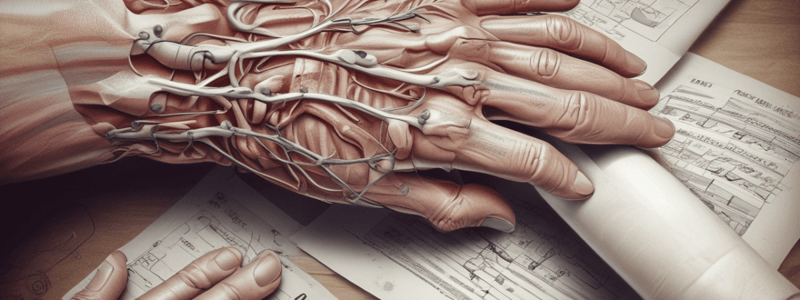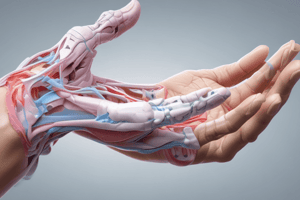Podcast
Questions and Answers
What is the primary goal of clinical examination after taking the patient's history?
What is the primary goal of clinical examination after taking the patient's history?
- To greet the patient and introduce yourself
- To follow the standard textbook routine for clinical examination
- To confirm or refute the suspected diagnosis and identify underlying causes and complications (correct)
- To assess the patient's hygiene and wash your hands
What is an essential aspect of preparing for a clinical examination?
What is an essential aspect of preparing for a clinical examination?
- Reviewing the patient's medical history
- Washing your hands and maintaining hygiene (correct)
- Checking the room temperature and lighting
- All of the above
When does the examination of a patient begin?
When does the examination of a patient begin?
- When you start asking questions about their medical history
- When the patient lies down on the examination couch
- When you introduce yourself to the patient
- From the moment the patient walks into the room (correct)
Why is repetition important in clinical examination?
Why is repetition important in clinical examination?
What should you try to achieve during the clinical examination?
What should you try to achieve during the clinical examination?
During the inspection of the hands, what is the healthcare professional looking for?
During the inspection of the hands, what is the healthcare professional looking for?
What is a vital part of the clinical examination process?
What is a vital part of the clinical examination process?
What is the term for the spoon-shaped deformity of the nails?
What is the term for the spoon-shaped deformity of the nails?
What is the name of the classification system used to categorize lymph nodes in the neck?
What is the name of the classification system used to categorize lymph nodes in the neck?
What is the purpose of the capillary refill test during the examination of the legs?
What is the purpose of the capillary refill test during the examination of the legs?
What is the term for the white transverse lines that appear on the nails in association with severe systemic disease?
What is the term for the white transverse lines that appear on the nails in association with severe systemic disease?
During the examination of the hands, what is the healthcare professional assessing when they check for sweating or dryness?
During the examination of the hands, what is the healthcare professional assessing when they check for sweating or dryness?
What is the name of the sign that indicates enlargement of the Virchow's node?
What is the name of the sign that indicates enlargement of the Virchow's node?
What is the term for the clubbing of the nails that is associated with congenital cyanotic heart disease?
What is the term for the clubbing of the nails that is associated with congenital cyanotic heart disease?
During the examination of the head and neck, what is examined in the ears?
During the examination of the head and neck, what is examined in the ears?
What is examined in the mouth during the head and neck examination?
What is examined in the mouth during the head and neck examination?
Why is a quick examination of the hands done?
Why is a quick examination of the hands done?
What is examined in the neck during the head and neck examination?
What is examined in the neck during the head and neck examination?
What is examined in the eyes during the head and neck examination?
What is examined in the eyes during the head and neck examination?
What is examined in the face during the head and neck examination?
What is examined in the face during the head and neck examination?
Flashcards are hidden until you start studying
Study Notes
Clinical Examination
- Importance of preparation for examination: privacy, attendant, room temperature, light, bed or examination couch, position for examination, tools for examination, hygiene of hands, and hand wash (infection control)
- General principles of examination:
- Use standard textbooks routine for clinical examination
- Practice clinical examination on many cases
- Form an idea about differential diagnosis or possible diagnosis after history taking
- Confirm or rule out suspected diagnosis
- Find causes and complications of diagnosis
Examination of Hands
- Inspection:
- Shape, size, color, and deformities of hands
- Number of fingers, shape, deformities, and swellings
- Color of hand (pallor, cyanosis, palmar erythema, staining)
- Muscle wasting
- Sinuses, scars, and ulcers
- Palpation:
- Temperature
- Tenderness
- Sweating or dryness
- Thickening or nodules
- Examination of nails:
- Color
- Shape (koilonychia, leukonychia)
- Clubbing (cardiac, respiratory, gastrointestinal, liver, and inflammatory bowel causes)
- Bean's lines (transverse white lines associated with severe systemic disease)
- Examination of circulation
- Examination of nerves:
- Tremor
- Muscle movements
- Sensations
Examination of Legs
- Inspection:
- Swelling (unilateral or bilateral, localized or generalized)
- Color of limbs
- Deformities
- Scars and sinuses
- Nails
- Ulcers
- Varicosities
- Palpation:
- Temperature
- Oedema
- Circulation (capillary refill test, pedal pulses)
- Examination of lymph nodes:
- Cervical nodes (circular group, vertical group, supraclavicular, Virchow's node)
- Axillary nodes
- Inguinal nodes
Examination of Head and Neck
- Ears:
- Shape, size, extra ears, discharge, and sinuses
- Eyes:
- Shape
- Pallor
- Jaundice
- Xanthelasmas and arcus senilis
- Eye movements
- Nose:
- Shape
- Discharge
- Mouth:
- Lips (cyanosis, ulcers, angular stomatitis, pigmentation)
- Tongue (cyanosis, pallor, dryness, size, ulcers, movements, deviation, swelling)
- Teeth (loss of teeth, artificial teeth, dentures, septic foci, dental hygiene)
- Oral mucosa (swellings, orifices of parotid and submandibular glands, dryness)
- Soft and hard palate (cleft palate and perforation, swelling)
- Tonsils and oropharynx
- Face:
- Deformity
- Color (pallor, malar flush, plethora, pigmentation)
- Ulcers or sinuses
- Swelling
- Neck:
- Swelling
- Thyroid
- Nodes
- Engorged neck veins
- Pulsations
- Ulcers, sinuses, and fistulae
Studying That Suits You
Use AI to generate personalized quizzes and flashcards to suit your learning preferences.




